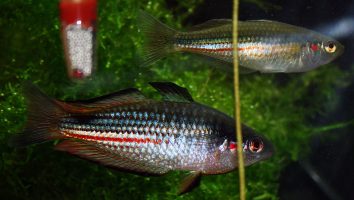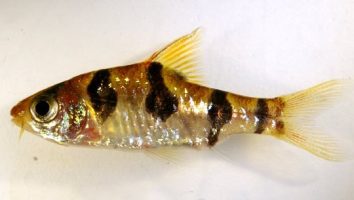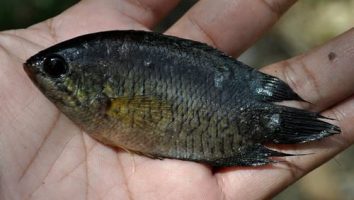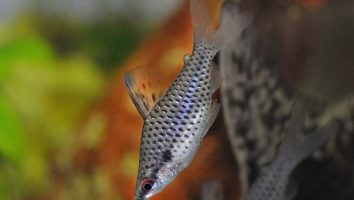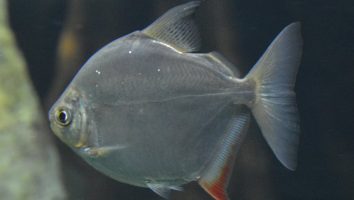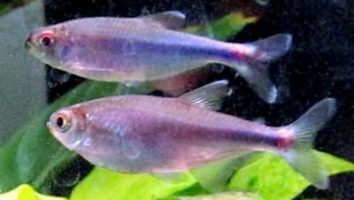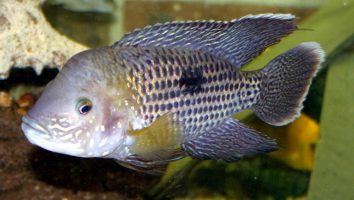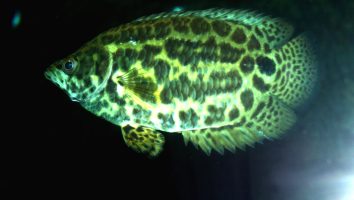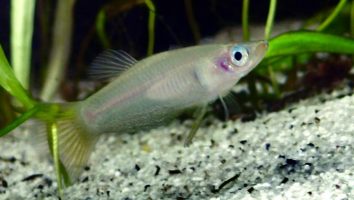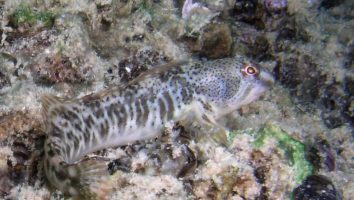The head and tail light tetra (Hemigrammus ocellifer) is a freshwater fish that originates from the Amazon basin. They’re a peaceful community fish that does well in groups of 6 or more.
This guide will teach you everything you need to know about head and tail light tetra care. You’ll learn about their diet, size, lifespan, and more!
Table of contents
Species overview
Head and tail light tetras (Hemigrammus ocellifer) are one of the most popular freshwater fish in the aquarium scene. They’re native to South America and can be found in Brazil, Guyana, and Suriname.
In the wild, they inhabit slow moving waters with a lot of vegetation. This provides them with plenty of places to hide and forage for food.
As their name suggests, these fish are distinguished by the bright red stripe that runs along their bodies from their head to their tail. This is a very striking feature and makes them a very popular choice for many freshwater aquariums.
Head and tail light tetras are very peaceful fish and get along well with most other tank mates. They’re a great choice for beginners and experienced aquarium enthusiasts alike.
Appearance
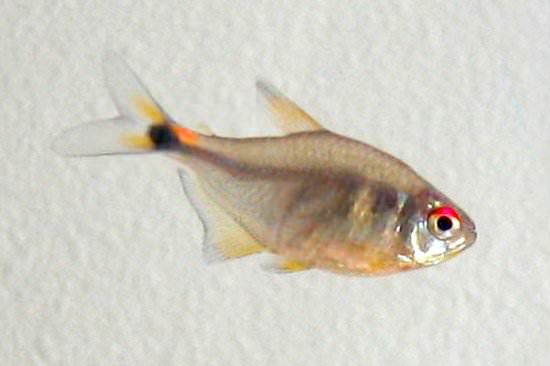
The Head and tail light tetra is a small freshwater fish that is very popular in the aquarium trade. As the name suggests, the most notable feature on this fish is the light that appears on both the head and tail.
This light is actually a photophore, which is an organ that produces light. The light is used to attract mates and startle predators.
The light on the head and tail is not the only thing that makes this fish stand out. They have a very long and thin body that is silver in color. The silver color is broken up by a black stripe that runs along the length of the fish. This stripe starts at the base of the head and extends all the way to the tail.
The fins on this fish are also quite notable. The dorsal fin is tall and thin, and the tail fin is forked. Both of these fins are transparent with a black stripe running through them.
The ventral fins are small and located just behind the head. The pectoral fins are located on the sides of the fish and are used for balance and stability.
Lifespan
Head and tail light tetras have a lifespan of 3 to 5 years. However, it’s not uncommon for individual fish to live much longer than that.
As with any other fish, the lifespan of head and tail light tetras is going to be determined by a number of factors. The quality of their environment, the food they eat, and the level of care they receive are all going to play a role.
Size
Head and tail light tetras are small fish, only growing to be about 1.5 inches in length when fully mature. Despite their small size, they still need a bit of space to swim and should be kept in an aquarium that is at least 20 gallons.
Tank
Tank Size
The recommended minimum tank size for head and tail light tetras is 10 gallons. If you want to keep a school of these fish we recommend at least 5 or 6 fish which would require a 20 gallon tank.
Tetras are social fish and do best in groups so we recommend going with the larger tank if you can. This will give them plenty of space to swim around and feel comfortable.
Water Parameters
Head and tail light tetras are some of the most popular freshwater fish in the hobby. They’re relatively easy to care for and make a beautiful addition to any community tank.
To ensure your head and tail light tetras thrive, it’s important to maintain the proper water conditions. These fish are native to the warm waters of South America. That means they prefer water on the warmer side with a neutral to slightly acidic pH.
Here are a few basic water parameters you’ll need to maintain for your head and tail light tetras.
- Water temperature: 75 to 82 degrees Fahrenheit
- pH levels: 6.0 to 7.2
- Water hardness: 2 to 12 dGH
- Alkalinity Levels: 4-8 dKH
What To Put In Their Tank
When it comes to setting up an aquarium for head and tail light tetras there are a few key things you need to take into consideration.
The first is that these fish come from South America so they’re used to living in warm water. That being said, you should try to keep the water temperature in their tank between 75 and 82 degrees Fahrenheit.
The second consideration is the size of their tank. Head and tail light tetras are pretty small so they don’t need a ton of space. A 20-gallon tank is more than enough for a small group of these fish.
The last thing to think about is the plants and decorations you’re going to put in their tank. These fish are known to be a little nippy so you need to be careful about the plants you choose.
We recommend sticking to hardy plants that can handle a little abuse (like Java Fern or Hornwort). As for decorations, rocks and driftwood are always a good choice.
Just make sure that everything you put in their tank is securely anchored. These fish are known for their vigorous swimming and they can easily uproot plants or knock over decorations.
Common Diseases
The head and tail light tetra is a hardy little fish that doesn’t usually get sick. However, that doesn’t mean they can’t catch an illness from time to time.
The most common disease that these fish experience is ich. This is a parasitic illness that will present itself as white spots on the body, fish, and gills of your fish.
While ich is fairly easy to treat, it can be deadly if left untreated. If you notice any of your fish exhibiting these symptoms, it’s important to act fast.
There are plenty of other potential diseases that can affect this species as well, but they’re not as common.
Another thing to look out for is infection from cuts. The most common cause of this is keeping your head and tail light tetra in a tank with a rough substrate (or aggressive species that want to fight).
In general, the best way to prevent these fish from getting sick is to maintain the quality of the water in their tank. A tank with clean and stable water conditions always leads to healthier fish who are more resistant to disease.
Behavior & Temperament
The head and tail light tetra (Hemigrammus ocellifer) is a peaceful little fish that is perfect for community tanks. These fish are social creatures that do best in groups of at least six. They are known to be shy, so a larger group will make them feel more comfortable and help reduce their stress levels.
In the wild, these fish are found in slow-moving waters in South America. They are used to hanging out near the bottom of the riverbeds and hiding in the vegetation.
In the home aquarium, you can recreate their natural habitat by adding a sandy substrate and plenty of plants. They like to stay hidden, so give them plenty of places to hide.
The head and tail light tetra is a timid fish that doesn’t like to be disturbed. They will startle easily and may even hide if there is too much activity in the tank. They are not aggressive and will not bother other fish in the tank.
Tank Mates
Head and tail light tetras (HTLs) are a peaceful and social species. In the wild, they live in large groups and stick to their own kind.
In the home aquarium, you can house them with other peaceful fish. They’re not aggressive, but they can be nippy if kept with long-finned fish.
HTLs are also mid-dwellers. They’ll occupy the middle and upper levels of the aquarium. Because of this, you can choose tank mates that stay mainly towards the bottom.
Some compatible species include:
- Neon Tetra
- Cardinal Tetra
- Black Neon Tetra
- White Cloud Mountain Minnow
- Rummy Nose Tetra
- Glowlight Tetra
- Harlequin Rasbora
Breeding
Head and tail light tetras are easy to breed as long as you provide them with the right environment. These fish are known as egg-scatterers. They don’t provide any care for their young once the eggs have been laid.
Start by setting up a breeding tank. It should hold at least 10 gallons of water. Then, add a lot of live plants. Tetras love plants and feel more comfortable when they’re surrounded by them.
Add a sponge filter to the tank. These fish are small and can easily get sucked into a power filter.
When ready, add two females for every male. These fish are known to be quite peaceful, so you don’t have to worry about aggression.
Feed the fish plenty of live foods. Then, begin changing about 50 percent of the water. That should trigger spawning.
You’ll know you’re successful when you see the female deposit eggs on the plants. After she does that, the male will fertilize them.
The eggs will hatch in about 24 hours. The fry will feed on the Infusoria that’s on your live plants. You can supplement that meal with freshly-hatched brine shrimp or crushed-up flake food. Make sure to feed the fry regularly to increase survival rates.
Conclusion
The head and tail light tetra is a beautiful and popular freshwater fish that is perfect for beginners. They are very easy to care for and can live in a wide range of water conditions.
These fish are also very peaceful and make a great addition to any community tank. They are a great choice for beginners and experienced fishkeepers alike.
If you’re looking for a beautiful and low-maintenance fish, the head and tail light tetra is a great choice.

